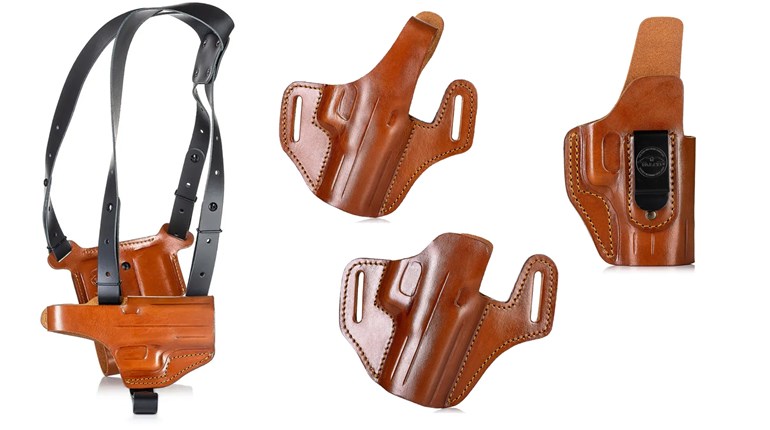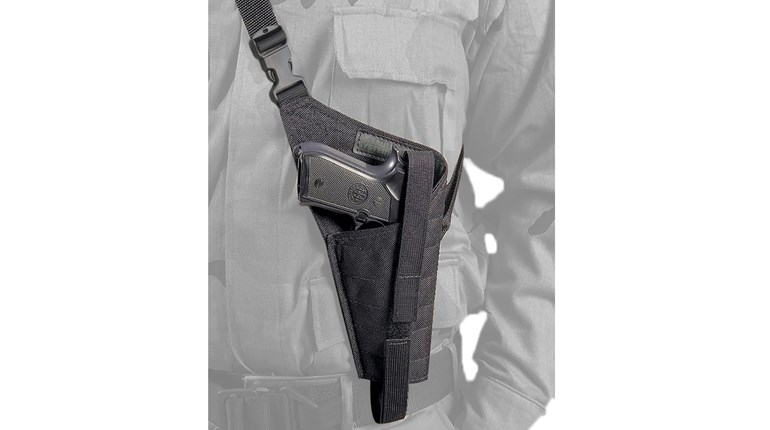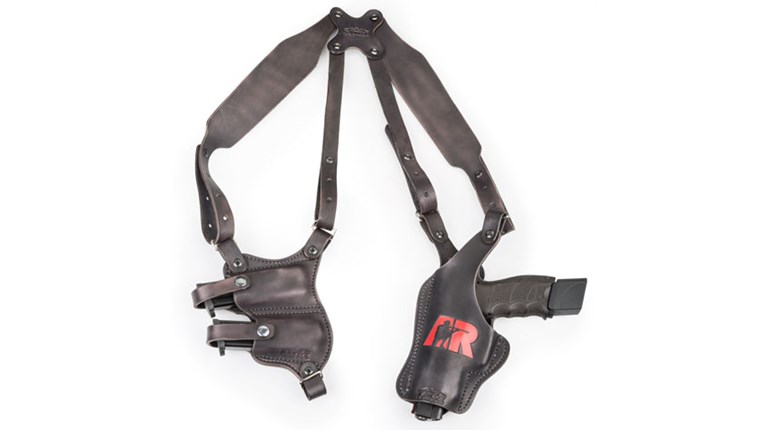
Carry Life has been considering the “home” side of carry lately. Differences—and important ones—aren’t long in popping up. When away, an urge to flight is wisely followed whenever possible, but this is the polar opposite of what appeals at home. If nothing else, the likely presence of family is a powerful motivation to protect and defend.
The availability of a defensive technology around the ol’ homestead is another source of unanticipated complexity. The tendency to believe wherewithal is close at hand is commonplace, yet a dry run or two generally reveals that getting to a safely stored firearm takes two or three times longer than we expect, and way too long to be useful should trouble come, ah, knocking.
If carry around the house seems the only response, other problems appear in short order. The first and worst may well be wardrobe, as trivial or even dumb as that sounds. Most of us don’t leave the house thinking we can wear just anything, and there is a kind of “tuning” of our wardrobes that may actually help with carry. Particularly for men, this has a lot to do with the relatively sturdy construction of our trousers, which improves our ability to carry at the waist. Unreasonable pain—either bodily or financially—can usually be avoided, and discreet carry options result.
Women don’t have it as easy—a fashion injustice about which we have no useful suggestions. Because women are generally lighter-statured, so, of course, are their garments. On-body carry is the best for many reasons, but is markedly tougher with even remotely fashionable wear. This is changing, but slowly; and we admire some of the ingenious workarounds we see, both commercial and individual. Well done, ladies.
But at home, both the lads and lasses have it altogether tougher. What is perfectly comfortable, acceptable, practical, even necessary may undermine home carry altogether. A tool belt that is more than mere convenience for a deck rebuild is a hopeless complication for virtually anything at the waist, for instance. And summer-weight shorts? They’ll be down around the knees in no time. Comfortable wear for women is even less substantial as “support” for carry.
Pocket carry may fill in some blanks for both genders. We’ve suggested that a smaller firearm can help here, and we stick by that recommendation. But remember our caveats as well: Small-pistol doctrine can be importantly different from that for full-sized or even compact pistols, which in turn requires both more and more diligent practice. No two ways about it—the smaller pistols are harder to master.
If carry around the house seems the only response, other problems appear in short order.Another crucial point: Protecting the trigger is essential to safe pocket carry, and a strong side pocket simply must be dedicated to the practice. This means no swapping from a front to rear pocket, or down to a cargo pocket. Pick one, and train with it in mind. Last but not least, the chosen gun-pocket is off limits to all other items, period, and it’s a wise habit to stick to even when you don’t carry there. Notice that if you pick a rear pocket, it may be more accessible with either hand. Front pockets, even of the cargo variety (lower on the leg), are generally less so.
There’s another offbeat possibility, maybe even a little heretical. The common, disadvantageous thread for most outside-the-home carry is dependence on clothing with structure at the waist. Particularly for women, this goes to pieces in much home wear. Men aren’t far behind, even if the reasons are different.
It may therefore be time to reconsider the maligned—and to some extent forgotten—shoulder rig. Seriously.
The original cause célèbre for the shoulder holster is no mystery—they stem from a time when gentlemen wore their jackets indoors and out, and removal was considered a consequential breach of decorum. Concealment of a firearm was an apt byproduct of the manners and fashions of a comparatively long period in Western culture that did not end until the 1960s.
They were—and are—not without advantages. Foremost, perhaps, is that they placed the burden of weight on the shoulders, and not on any part of a garment. In vehicles without seat belts, or while more generally seated, access could be surprisingly rapid. In a pinch, either hand could be used. Either vertical style—muzzle up for many small firearms, muzzle generally down for larger types—could also give good to very good concealment, and particularly in cover garments tailored with that purpose in mind.
Later types often held the weapon horizontally; quicker to deploy, it’s true, but often less discreet. Then there’s that muzzle-pointing-at-bystanders business—unwelcome, at least. Last came the need for quite careful fitting and donning. For concealment to be credible, straps that crossed the upper back needed to be unusually smooth and close-fitting, and were thus often flimsy and tangle-prone. Shoulder “drape” models tried to overcome this with a pad structure from which the holster and magazine pouches (often a counterweight as much as anything else) would hang. Often, either one or both sides would loop around the belt to tension the whole apparatus vertically.
In a word, they were and are complex.
What is perfectly comfortable, acceptable, practical, even necessary may undermine home carry altogether.When considered for home carry in the modern era, however, many of the “knocks” on shoulder rigs don’t come much into play. The main indictment is probably concealment. If you’re outdoors on your own property, this may no longer be an obligation, though courtesy and sound tactics recommend discretion all the same. Modern materials make a comfortable cover garment easy to come by, the more used-looking, the better. Improvise and vary is our suggestion. A little discreet hook-and-loop will keep you from alarming neighbors in every breeze from atop the John Deere, too.
Indoors, even a light cover garment can be dispensed with. Loose attachment at the waist is advisable because it restrains “swinging” as you turn or bend (an outside expedient of advantage too, naturally). Unlike most belt configurations, it may have occurred to you that one can even … well, never mind. It’s a very personal sort of advantage is all we need say.
If we’ve made our case, there are few additional points to consider before running out to acquire. Part of the decline in the popularity of shoulder rigs was a function of lopsidedness; it was tough to balance even a middling sized Smith revo on the left against speed loaders or dump pouches on the right. A 1911—at somewhere north of 41 ounces—took real dedication.
Polymer pistols change this equation considerably. Not only does overall weight go down, but the offset from left to right eases. Getting to comfort and balance is a lot simpler with a 23-ounce, plus-2 Glock 43 on the right, for instance, and two 8-rounders on the left.
When considered for home carry in the modern era, however, many of the “knocks” on shoulder rigs don’t come much into play.Old and new(er) experience suggests another caution: Like any other holster purchase, it’ll pay to take your time moving to a shoulder rig. For starters, they can be expensive. When we first sorted this out, we had a simple Bianchi nylon number with nice broad straps. It was surprisingly comfortable in the end—we still have it, and still use it 25 years later—but it took about two months to get all the adjustments "just so.” Unlike a belt rig with cant and azimuth as about the only variables, geometry matters a lot in getting to shoulder-borne comfort. But we can throw our home carry rig on with practiced ease these days, and wear it far longer than any other, and in more circumstances. (A hint on cost: We’ve seen a couple folks grab a “test unit” out of the bargain bin, and use this to make their decision. Especially if you can find a muzzle-down generic, you can muster a surprisingly good dry run for $10-20.)
We won’t let you go without harping on training, and for shoulder rigs, the upshot is particularly practical. Remember that the start position has you pointing the gun the wrong direction for most RSO sensitivities, or for any educated person astern of you for that matter. Most ranges can accommodate as long as your gun handling is sound. If they’re flummoxed, suggest the left-most position for a righty, opposite for lefties. Then keep your finger off the trigger until you’re on target and ready to fire.
Now Carry on.
Frank Winn has been studying arms and their relationship to tyranny, meaningful liberty and personal security all his adult life. He has been a firearms safety/shooting instructor for more than 20 years, and earned state, regional and national titles in several competitive disciplines.


































